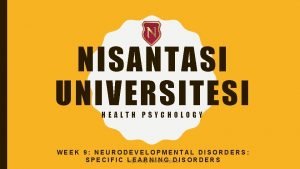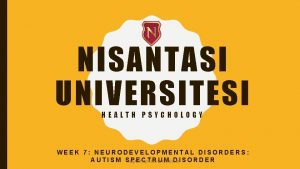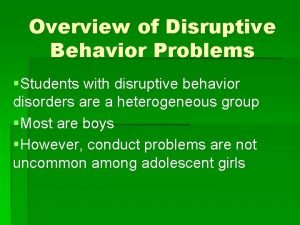NISANTASI UNIVERSITESI HEALTH PSYCHOLOGY WEEK 10 DISRUPTIVE IMPULSIVECONTROL










- Slides: 10

NISANTASI UNIVERSITESI HEALTH PSYCHOLOGY WEEK 10: DISRUPTIVE, IMPULSIVE-CONTROL, A N D C ONİŞANTAŞI N D U CÜNİVERSİTESİ T DISO © RDERS

DISRUPTIVE, IMPULSIVE-CONTROL, AND CONDUCT DISORDERS Oppositional Defiant Disorder In children with Oppositional Defiant Disorder (ODD), there is an ongoing pattern of uncooperative, defiant, and hostile behavior toward authority figures that seriously interferes with the youngster’s day to day functioning. Symptoms of ODD may include: • Frequent temper tantrums • Excessive arguing with adults • Often questioning rules • Active defiance and refusal to comply with adult requests and rules NİŞANTAŞI ÜNİVERSİTESİ ©

OPPOSITIONAL DEFIANT DISORDER • Deliberate attempts to annoy or upset people • Blaming others for his or her mistakes or misbehavior • Often being touchy or easily annoyed by others • Frequent anger and resentment • Mean and hateful talking when upset • Spiteful attitude and revenge seeking NİŞANTAŞI ÜNİVERSİTESİ ©

OPPOSITIONAL DEFIANT DISORDER • The symptoms are usually seen in multiple settings, but may be more noticeable at home or at school. One to sixteen percent of all school-age children and adolescents have ODD. • The causes of ODD are unknown, but many parents report that their child with ODD was more rigid and demanding that the child’s siblings from an early age. • Biological, psychological and social factors may have a role. NİŞANTAŞI ÜNİVERSİTESİ ©

INTERMITTENT EXPLOSIVE DISORDER • Kids with intermittent explosive disorder (IED) exhibit short episodes intense, uncontrollable anger or aggression with very little or no apparent cause. It usually shows up in late of childhood or adolescence, and eventually leads to a higher risk of self-harm or suicide in adolescents and young adults. • NİŞANTAŞI ÜNİVERSİTESİ ©

INTERMITTENT EXPLOSIVE DISORDER • Adolescents with IED have low frustration tolerance and are disproportionately enraged by small annoyances, often becoming verbally and physically aggressive, sometimes causing property damage or even physical injury. • Road rage, breaking furniture and getting into fights are all common behaviors for people with the disorder. • They describe feeling overcome with anger and “out of control. ” Some experience a sensation of building tension in the head or chest that is finally released when they react aggressively. • The explosions are typically brief, less than 30 minutes, and are not premeditated, or aimed at some tangible objective. NİŞANTAŞI ÜNİVERSİTESİ ©

CONDUCT DISORDER • "Conduct disorder" refers to a group of behavioral and emotional problems in youngsters. Children and adolescents with this disorder have great difficulty following rules and behaving in a socially acceptable way. • They are often viewed by other children, adults and social agencies as "bad" or delinquent, rather than mentally ill. • Many factors may contribute to a child developing conduct disorder, including brain damage, child abuse or neglect, genetic vulnerability, school failure, and traumatic life experiences. NİŞANTAŞI ÜNİVERSİTESİ ©

CONDUCT DISORDER • Aggression to people and animals • bullies, threatens or intimidates others • often initiates physical fights • has used a weapon that could cause serious physical harm to others (e. g. a bat, brick, broken bottle, knife or gun) • is physically cruel to people or animals • steals from a victim while confronting them (e. g. assault) • forces someone into sexual activity NİŞANTAŞI ÜNİVERSİTESİ ©

CONDUCT DISORDER • Destruction of Property • • • deliberately engaged in fire setting with the intention to cause damage deliberately destroys other's property Deceitfulness, lying, or stealing has broken into someone else's building, house, or car lies to obtain goods, or favors or to avoid obligations steals items without confronting a victim (e. g. shoplifting, but without breaking and entering) Serious violations of rules often stays out at night despite parental objections runs away from home often truant from school NİŞANTAŞI ÜNİVERSİTESİ ©

RESOURCES American Psychiatric Association. (2013). Diagnostic and statistical manual of mental disorders. (5 th ed. ). Arlington, VA: American Psychiatric Publising Ollendick, T. H. & Hersen, M. (1989). Handbook of Child Psychopathology. Second Edidtion. New York: Plenum Press Rutter, M. & Sroufe, L. A. (2000). Developmental Psychopathology: Concepts and challenges. In Developmnet and Psychopathology, 12 265 -296 NİŞANTAŞI ÜNİVERSİTESİ ©



















